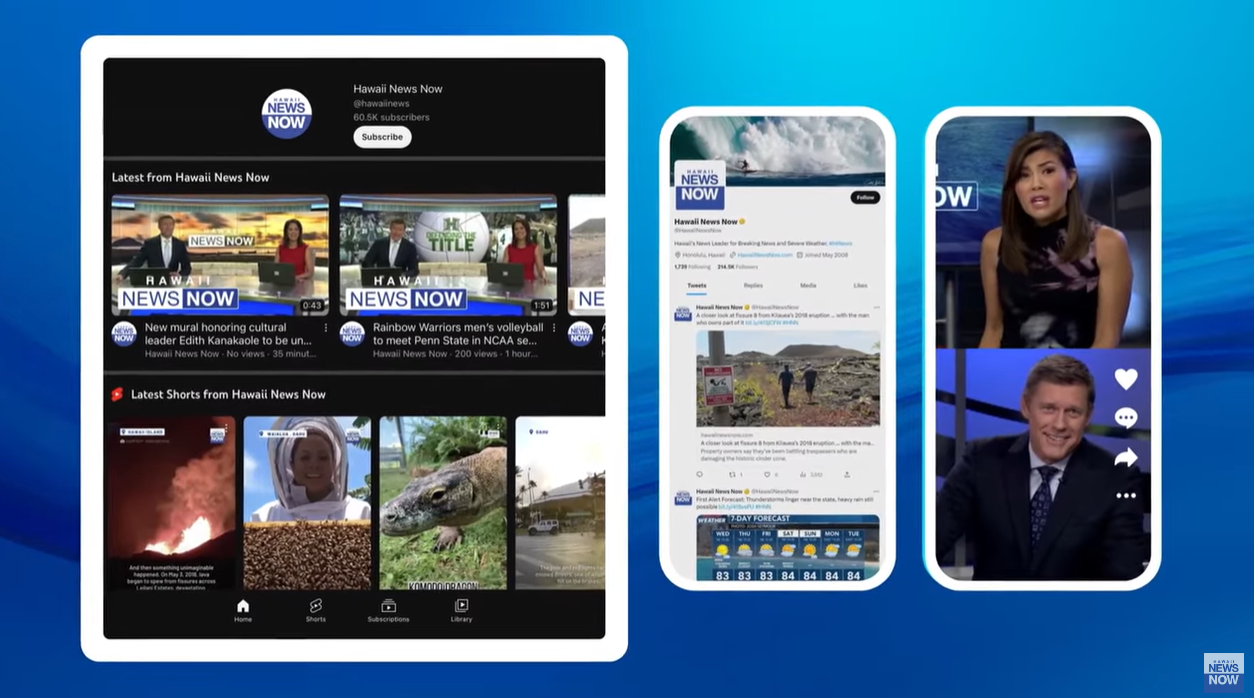Hawaii News Now, a three-station news operation, has unique coverage requirements due to the state’s history and natural beauty which draws tourists. But it shares the conundrums all local TV stations are facing.
Most people think of Hawaii as a vacation destination, a place to go to enjoy warm weather, beaches and outdoor activities for a couple of weeks and then go back home. That makes tourism a dominant issue for news coverage on the islands.
Hawaii is probably the most unusual state in our union, some 4,000 miles away from the rest of America, with a different history.
While early colonists were breaking away from being England’s possession in 1778, Hawaii was just being discovered after thousands of years of isolation.
And Hawaii became the 50th state relatively recently, joining the Union in 1959.
So, given that, how is local TV news coverage different on the Gray-owned Hawaii News Now than one might find on the mainland?
Hawaii News Now itself is a bit different.

Katie Pickman has been at Hawaii News Now for six years, the last three as general manager.
“Hawaii News Now came together in 2010,” Pickman says, explaining that the brand comprises two major stations — KGMB, the CBS affiliate, and KHNL, the NBC affiliate — plus the independent KFVE.
Everyone works in the same newsroom, and while much of the news is simulcast across all three stations, Hawaii News Now has unique products for each station, Pickman says. “We broadcast over 60 hours of news per week across three main stations.”
Residents have a particularly big appetite for news.
“People tend to watch more news here in the islands,” Pickman says. “Part of it is we are so isolated, and people really need to know what is going on.”
Tourism, the largest economic driver in Hawaii, along with how it affects the islands, is a constant part of news coverage.
“In 2019 we hit an historic high with 10 million visitors coming in,” Pickman says. “That really put pressure on our resources here. Up to 30% of the people that are on any one of these islands at a time are visitors. Our size and infrastructure have not been set up for that.”
Another facet of tourism coverage is the imperative to “treat this place as a special opportunity to learn and see the culture,” Pickman says.
The island population is a real melting pot, she adds. While the largest makeup of the island demos is Filipino followed closely by Japanese, Chinese and Korean, and issues related to those populations are a priority, the native Hawaiian culture (Kamaʻāinais is the Hawaiian name for locals) is very important to the whole place and is part of the daily news coverage, she says.
“There are native rights issues, land issues, all sorts of pieces that are a daily topic as a separate piece of our news,” Pickman says.
She says the stations just broadcast 18 hours of the largest hula festival in the world for global audiences with people in 151 countries watching the content.
During the broadcast of that festival, local advertisers wanted to run commercials with a specific message about hula, language and preservation of resident culture.
“Not only in news, but outside news we make sure that we are covering our culture,” she says.
There’s been a resurgence of traditional native cultural values and practices of late, Pickman adds. “We are very careful in making sure that our team reflects our community. We have people from many different ethnicities that represent Hawaii on our team including native Hawaiian reporters and hosts for our programming.”

Robyn Kenney, the marketing director for Hawaii News Now, has a fresh perspective on the differences and similarities in how news is covered in Hawaii versus the mainland. Keeney herself has only been in Hawaii since October, coming from Indianapolis.
Kenney says the fact that residents are living on islands surrounded by ocean makes the lighter news more interesting.
“We had a monk seal that had a baby, and everyone was very excited,” Kenney says.
But the issues that ring true for news coverage in many mainland markets are important for residents here too. Those include investigative reporting, traffic, the high cost of living, political corruption, affordable housing, crime and homelessness, she says.
And then there’s the weather. Residents feel especially vulnerable when it comes to weather, being an island chain in the middle of the Pacific Ocean.
Here, Hawaii News Now’s brand of First Alert Weather has particular resonance.
The most notable similarity that Hawaii News Now shares with the rest of the TV stations on the mainland is the push to be digital first.
To that end, the stations launched a promo aimed at the buying community that took the notion of television versus digital and turned it on its head, Kenney says.
“I have been doing TV promos for a while and usually we say we are on TV at these times,” Kenney says. “So, the idea with this was to flip-flop it and say we are sharing your stories everywhere, on any screen someone would want to watch content.”
That said, Pickman says television is still the largest revenue driver for the stations.
“But our digital clientele is growing quickly,” she says. “We had our largest digital revenue month ever in April and it set records for us. We are experimenting with how to drive people from TV to digital and social, but also how do we bring them from digital to TV. It is ongoing, trying to be agile with how people want to consume our content.”





Comments (0)
Reader Interactions